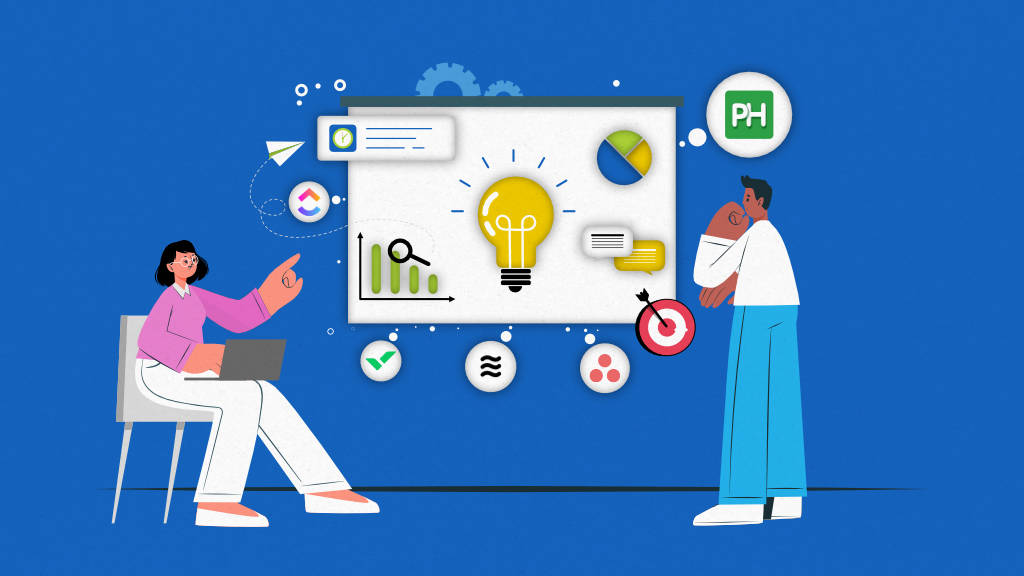To create an effective project plan, a project manager needs to communicate with key stakeholders, have a clear understanding of the company’s available resources (including people, budget, and time), and share information with project team members.
Project planning software is a platform that provides you with a set of tools to facilitate the project planning process. It allows you to engage in discussions with key stakeholders, share files and documents with team members, create tasks, define workflows, set dependencies between tasks, and visualize workload to create an effective project plan.
In this post, we will look at the top 10 project planning software. I have explained the key features, pros, and cons of each tool and defined for whom each tool is best suited. Read this post to make an informed decision for your organization.
What is project planning software?
A project planning software is a digital collaboration platform that provides a range of features or tools to help users execute the project activities involved in creating a project plan. It allows users to communicate with each other, share documents, and create and plan tasks in a project.
I am not going into the details of every activity included in the project planning and how a project management software helps you perform that activity, rather explaining the basics, because otherwise I have to discuss risk register, WBS, cost estimation techniques, RACI matrix, etc., which will be out of the scope and intent of this article. To learn about project planning, you can refer to my in-depth guide on project management.
A Free guide to help you with proven ways to lead a project from start to finish, without confusion or jargon.

Key features to look for in a project planning software for teams
A project planning software helps you create a project, break a project into tasks and subtasks, set start and due dates of a task, assign owners, add key details of a task, set dependencies between tasks, visualize resource schedule and workload, and facilitate collaboration between project team members on tasks. Have a look at the key features of project planning software that help you perform these activities.
- Task management: Ability to break a project into tasks and subtasks to create a Work Breakdown Structure, create a workflow to define the stages of a task from start to finish, and assign an owner to the tasks and add key details of a task, such as start and due dates, estimated resources, etc
- Gantt chart: A Gantt chart to set dependencies, define milestones, and visualize the project plan on a timeline
- Discussions: Group discussion or chat to facilitate real-time communication
- File sharing: Share files from local and cloud storage to share the documents with stakeholders
- Project views: Multiple project views, such as board, table, and calendar, to track status progress
- Project reports: Various project reports to track the project progress, resource allocation, project, and team performance
- Time tracking: Time tracking to track the time spent on tasks and create timesheets
Read more: What are the different types of project management software?
9 Top project planning software for project teams in 2026
I have tested over 20+ popular project planning software found during my research and shortlisted the top 9 software and explained “the category” in which each software is best for you to help you make an informed decision.
To make my decision, I have kept the following factors in mind while evaluating the software:
- Features to support project planning and execution: I make sure each software has the basic project planning software listed above
- Expertise in specific use case: I figured out the area where a software excels in because every software has different areas of strength and focus, and based on that, I have explained the use case
- Ease of use and learning curve: I have evaluated the ease of use of the software and the training and learning requirements
- Pricing & value for money: I have kept in mind the pricing of each tool and the value it offers
- Public Reviews: I take into account the public reviews of real users to make an unbiased and reasoned decision
1. ProofHub: Best for team collaboration
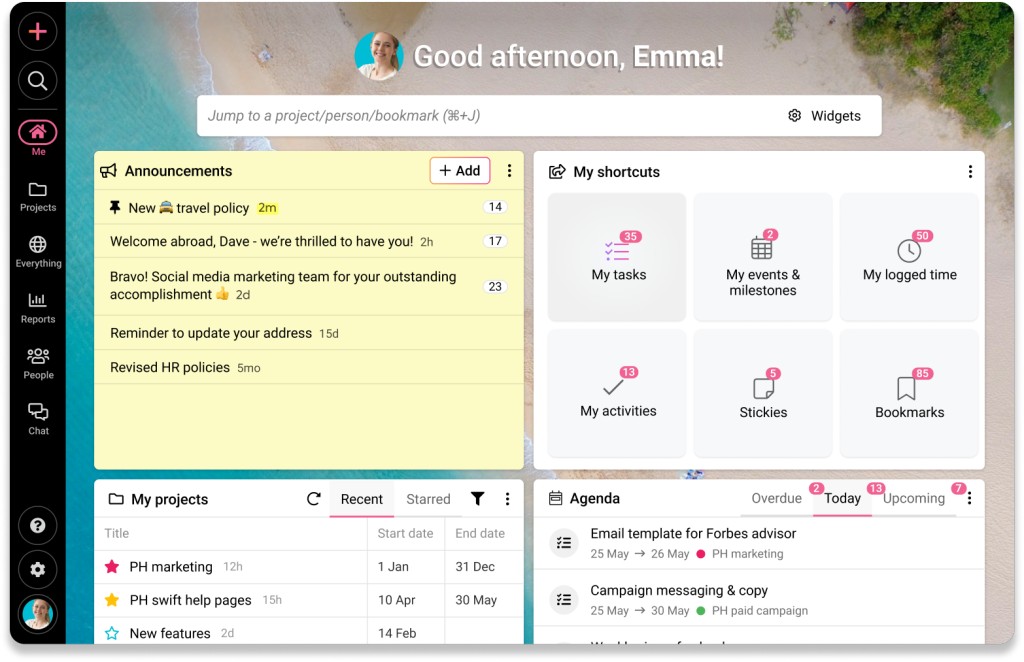
ProofHub is an all-in-one project management and team collaboration software that helps you create and execute a project plan with a vast range of project management features. It allows you to break a project into smaller tasks and subtasks, set dependencies between tasks using a Gantt chart, visualize and allocate resources with a calendar, and collaborate with team members directly on tasks with task comments and file sharing.
The platform excels in built-in team collaboration capabilities, such as chat to facilitate real-time conversations, proofing to review, edit, and share feedback on digital assets, and team announcements for company-wide engagement.
Ease of use and learning: It is one of the most easy to use and learn software in the list. It comes with a simple interface and a minimal learning curve. Users of any level of experience can learn this tool with minimal training. Ideal for beginners.
Pricing & value for money: ProofHub is the most competitively priced platform in the list, with a flat fee pricing structure. It means you do not have to pay a per-user fee. For one flat fee, you can add as many users as you want. The rest of the tools in the list charge a per-user fee.
Key features
- Hierarchical breakdown of a project to implement the work breakdown structure (WBS)
- Task management to add key details of tasks such as assignee, start and due dates, estimated resources, description
- Custom workflow to define the flow of tasks in a project
- Gantt chart to set dependencies, add milestones, visualize project plan, create a baseline, and highlight critical path
- Task comments and file sharing directly on tasks to streamline collaboration
- Built-in chat to facilitate real-time communication
- Time tracking to track the time spent on tasks and create timesheets
- Project reporting to overview the project progress and performance
- Multiple project views, including Board and Table and and custom filters to track the status progress at a glance
- Calendar to visualize resource schedule
- Custom roles to manage access and permissions
Pros
- Easy-to-use platform with a simple user interface
- Ease to learn with a minimal learning curve
- Most competitive priced due to a flat-fee pricing structure
Cons
- Limited advanced project planning, budgeting, and execution features
- Does not have a suitable plan for an individual or a single user
Pricing
ProofHub offers two flat-fee paid plans with a 14-day free trial:
- Essential: $45 per month for unlimited users, up to 40 projects, and 15GB storage, billed annually
- Ultimate Control: $89 per month for unlimited users, unlimited projects, and 100GB storage, billed annually
Ratings
- G2: 4.6/5
- Capterra: 4.6/5
2. Asana: Best for capacity planning and workload balancing
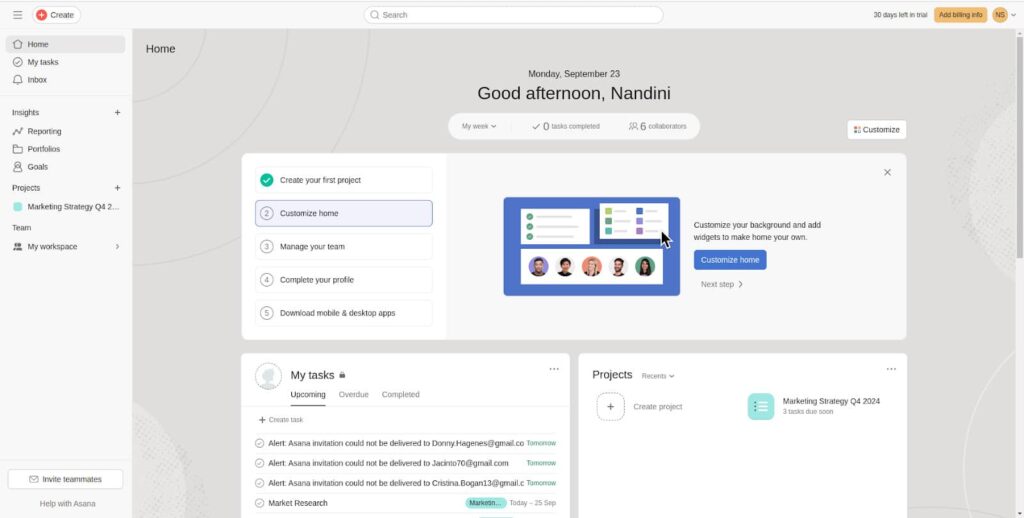
Asana is a work management software that helps you plan projects, manage tasks, and collaborate with team members from a single platform. It allows you to create projects, break projects into tasks and subtasks, set dependencies between tasks, and collaborate with team members on tasks.
Asana excels over other tools in advanced resource management and goal management. It allows you to set goals at the company, project, team, and individual levels and align these goals together. With resource management features like capacity planning, workload rebalancing, and reports and dashboards, it helps you take control over company resources – optimization, scheduling, and allocation.
Ease of use and learning: Asana has the best user experience of all the tools, with a basic, clean, and well-organized interface. It comes with a decent initial learning curve, but overall, it is easy to use as compared to other apps like Wrike, Smartsheet, and Jira with the same level of advanced features.
Pricing & value for money: Asana is the most expensive software in the list because it has a higher price, and on top of that, its feature set is limited. You need to rely on integration with third-party apps for many features and pay the subscription fees for those features that many apps offer natively.
Key features
- Set goals at the company, project, team, and personal levels
- Timeline to set dependencies and visualize progress
- Advanced project resource planning, workload balancing, and scheduling capabilities
- Message to communicate with the team on projects
Pros
- A wide range of templates to get started
- Workflow automation to save time
- AI for brainstorming, summarizing, and plan creation
Cons
- Asana has messages, but it is more of an email thread
- Basic Timeline view, but not a full-fledged, advanced Gantt chart
- Relies on integration for many project management features, such as proofing, time tracking, and chat, that other tools offer natively
Pricing
Asana offers three plans:
- Personal: Free up to 10 team members, but without automation and AI
- Starter: $10.99 per user per month, billed annually
- Advanced: $24.99 per user per month, billed annually
Ratings
- G2: 4.4/5
- Capterra: 4.5/5
Read more: Best Asana alternatives for teams
3. Gantt Pro
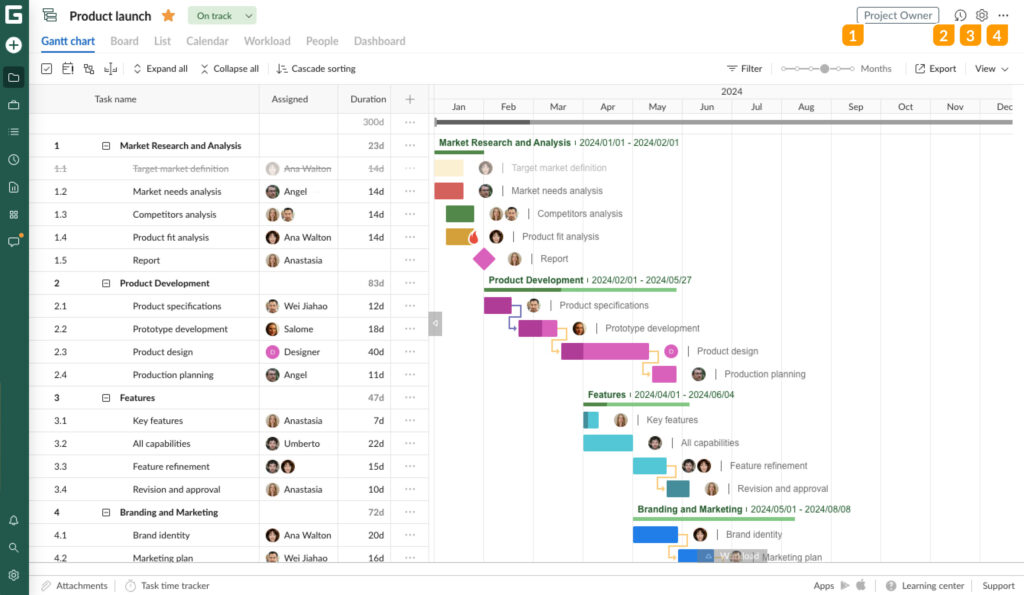
Gantt Pro is a Gantt-chart-based project management software that provides one of the most advanced Gantt charts to users to plan, manage, and execute a project. The platform automatically builds a Gantt chart for you – create a project, break it into a group of tasks, and add tasks, dates, and resources. The platform creates a Gantt chart and starts working on your projects individually or with your team.
The key highlights of Gantt Pro are that its Gantt charts show tasks, dates, deadlines, dependencies, and assignees directly from a Gantt chart, you can collaborate directly on a Gantt chart as each task is a collaborative space, and you can use custom filters to view the details you need on a Gantt chart.
Ease of use and learning: Gantt Pro has the most ease to use Gantt chart. It is generally beginner-friendly software with a minimal learning curve that your team can easily learn to use.
Pricing & value for money: It is generally an expensive software for users who are looking for a comprehensive range of project management features. However, for Gantt chart users who need basic project planning, management, and execution capabilities, it provides good value for money.
Key features
- Task hierarchy to break down the project into a group of tasks
- Gantt chart to set dependencies, create a baseline, highlight critical path, and visualize milestones
- Multiple project views, such as Portfolio, Grid, and Board, to visualize project tasks at a glance
- Task comments and file attachments to collaborate with team members
- Time tracking to create time logs
Pros
- Customize your project and add custom fields to track and measure as many crucial aspects of your plan as possible
- The most beginner-friendly Gantt chart with advanced features
Cons
- No real-time chat
- Lacks advanced reporting and dashboard capabilities
Pricing
Gantt Pro offers four plans:
- Core: $7 per user per month, billed annually
- Advanced: $10 per user per month, billed annually
- Business: $17 per user per month, billed annually
- Enterprise: Custom pricing
Ratings
- G2: 4.8/5
- Capterra: 4.8/5
Read more: Gantt chart tools & software for dynamic project management
4. Smartsheet: Best for spreadsheet users
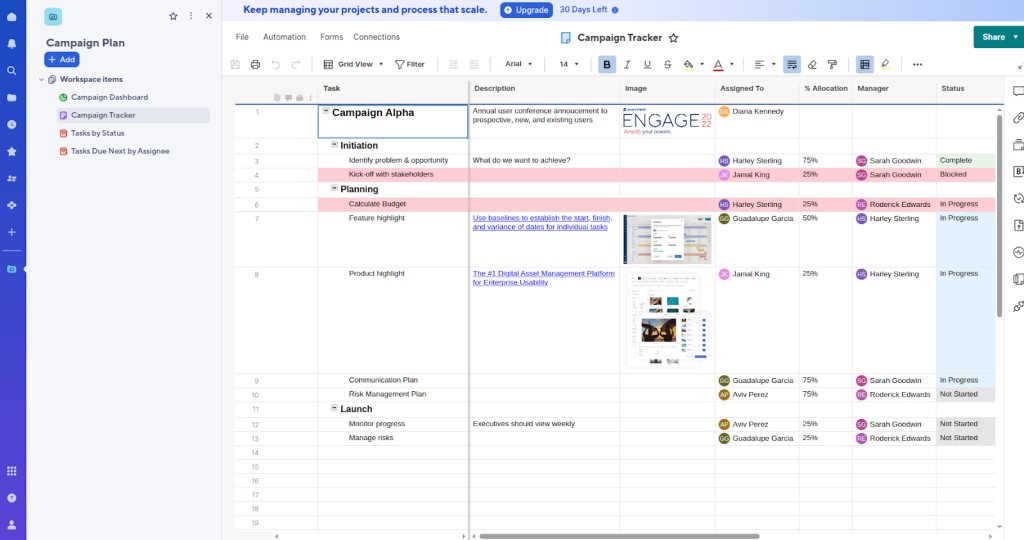
Smartsheet is a spreadsheet-interface-based project management software that helps you plan, execute, and manage tasks in a project. It is an ideal choice of project planning software for users who want something similar to spreadsheets but do not want the manual efforts of managing and storing data, creating Gantt charts, and remembering formulas to prepare project reports. It is a powered-up version of Spreadsheet that does everything automatically.
Ease of use and learning: Smartsheet is easier to use than Excel Spreadsheets for creating Gantt charts, reports, and project plans, but in general, compared to other platforms, its user interface is complex, and it requires training and time to learn to use the tool. You can expect a steep initial learning curve.
Pricing & value for money: Smartsheet is an expensive platform for small businesses, but for large to mid-sized businesses with a need for advanced project planning and portfolio management features, it offers decent value for money.
Key features
- Custom table with rows and columns to manage tasks
- Conversation to mention people at the table for collaboration
- Workload tracking and resource management to identify workloads and allocate resources
- Admin controls, custom roles, and permissions to manage access
Pros
- Built-in templates to get started with project management
- Automation to automate workflows to save time
Cons
- A steep learning curve makes onboarding and set-up challenging
- Smartsheet does not have chat
- Expensive software requires paid add-ons or upgrading to paid plans for advanced features such as workload tracking, unlimited automation, and time tracking
Pricing
Smartsheet offers three paid plans:
- Pro: $9 per user per month, billed annually
- Business: $19 per user per month, billed annually
- Enterprise: Contact the sales team
Ratings
- Capterra: 4.5/5
- G2: 4.4/5
Read more: Best Smartsheet alternatives for teams
5. Wrike: Best for enterprise-grade project planning and management
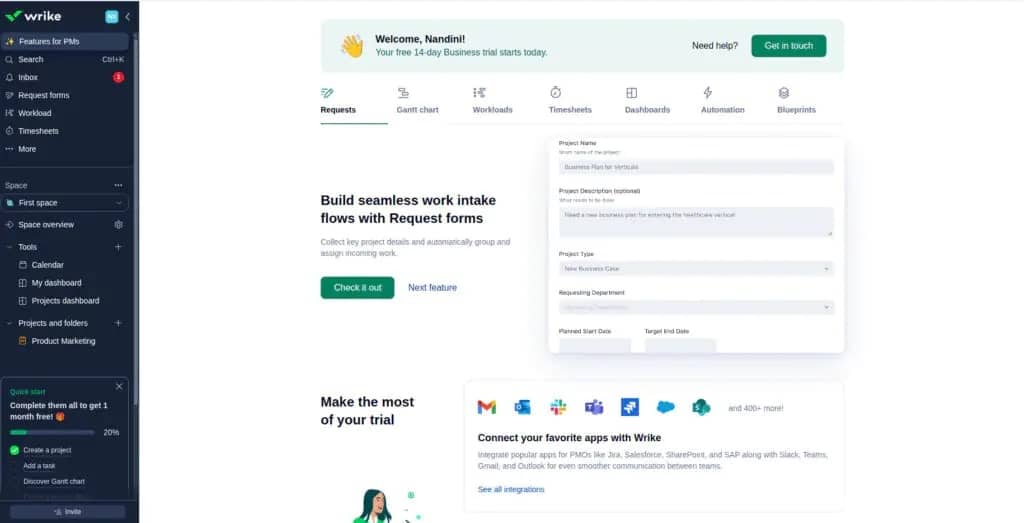
Wrike is an enterprise-grade work management platform that helps you manage the intake, planning, and execution of multiple projects in a portfolio with shared resources and multiple portfolios from a centralized place, with its range of project planning and management features. It helps you streamline project intake and approval requests, visualize, plan, forecast, book, and allocate resources across the projects, and take control of the project and portfolio analytics with custom dashboards and reports.
Ease of use and learning: Wrike comes with a steep learning curve. Initially, it was not easy to use. Your team will require onboarding training and tutorials. The user interface is a bit complex for first-time users of project management software, but over time, one can get used to the platform.
Pricing & value for money: Wrike is an expensive project management platform, but it offers a higher value for money with its vast range of features, enterprise-grade security, exceptional support, and reliability and stability of the platform. Ideal for large teams with a large number of projects and resources shared across the projects.
Key features
- Gantt charts are used to create a project schedule and manage dependencies
- Workload charts, resource booking, and workload balancing for resource management
- Advanced real-time dashboards with customizable widgets to overview project and portfolio progress
- Real-time collaboration with file attachments, cross-tagging, and Wrike Document Editor to corresponding tasks
Pros
- Most reliable, stable, and bug-free platform
- Enterprise grade security with 2FA, SSO, and SOC2, ISO27001, and HIPPA compliance
Cons
- Steep learning curve with a complex user interface
- Highly priced platform with advanced features in the top-tier paid plans
- No built-in chat, only task comments, relies on Slack or Teams
Pricing
Wrike offers five plans:
- Free: With limited features
- Team: $10 per user per month, 2-15 users, billed annually
- Business: $25 per user per month, 5-200 users, billed annually
- Enterprise: Custom pricing, 5 to unlimited users, billed annually
- Pinnacle: Custom pricing, 5 to unlimited users, billed annually
Ratings
- G2: 4.2/5
- Capterra: 4.3/5
Read more: Best Wrike alternatives to try
6. nTask: Best for project risk management
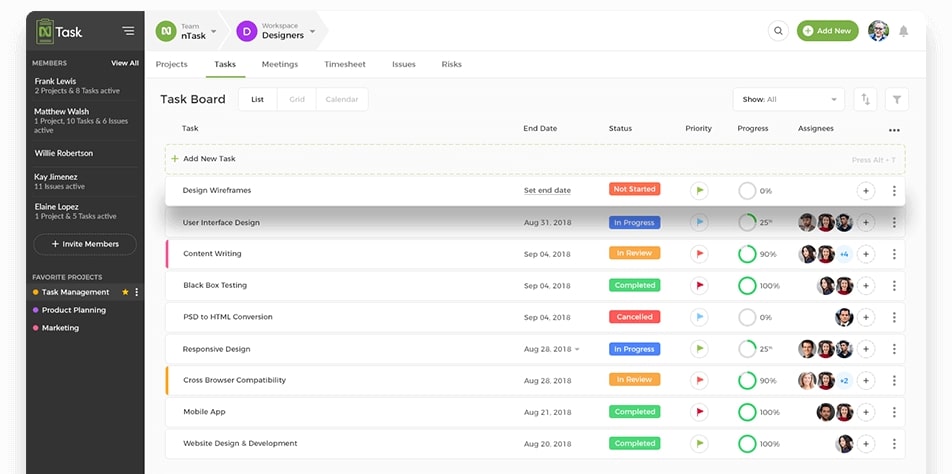
nTask is a project management platform that provides built-in risk management capabilities along with project planning, task management, time tracking, team collaboration, and meeting management capabilities. The platform helps you identify project risks, assign risk owners, create mitigation plans, analyze with a risk matrix, and mitigate your risks.
Ease of use and learning: nTask’s user interface is not beginner-friendly, and it takes time to get used to and learn the tool.
Pricing & value for money: nTask is a budget-friendly platform with pricing starting from $3 per user per month, less than three times that of Asana, Smartsheet, and Wrike first tier paid plan. It offers a decent range of features, making it highly valuable for money.
Key features
- Gantt chart to assign tasks, set planned and actual due dates, create task dependencies, and set milestones
- built-in chat to connect anytime with your project team
- Risk assessment matrix to identify, document, and plan for all the risks
- Comprehensive reports to track performance metrics within the team
Pros
- Easy to use, one can get started and manage tasks efficiently
- More affordable compared to the competitor
Cons
- Lacks advanced reporting features
- Limited integrations with third-party software
Pricing
nTask offers four plans:
- Basic: Free for a team with up to 5 people
- Premium: $3 per user month billed annually
- Business: $8 per user month billed annually
- Enterprise: Contact sales for pricing
Ratings
- G2: 4.4/5
- Capterra: 4.2/5
7. ClickUp: Best for advanced collaboration tools
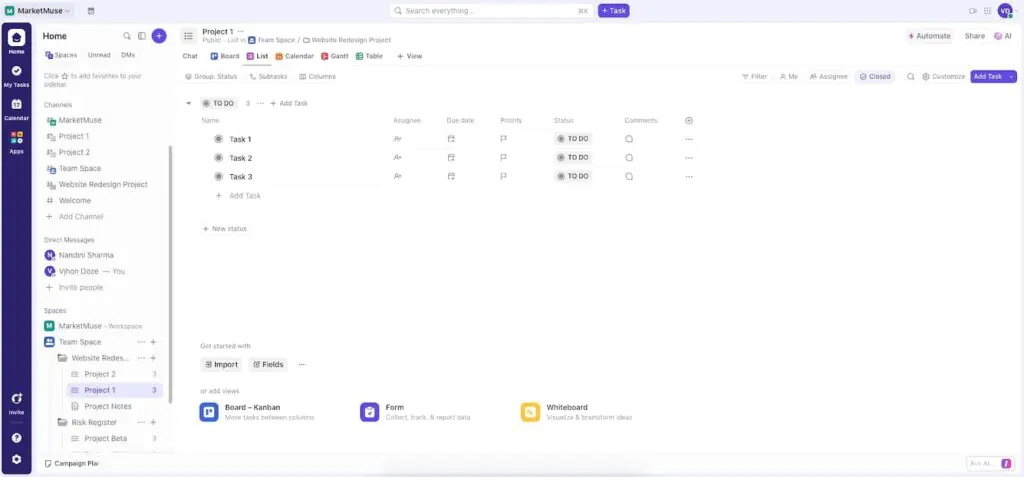
ClickUp is a feature-rich, all-in-one work app that focuses on improving team productivity by bringing people, projects, and documents to one place. You can plan projects, execute tasks, collaborate with a team, and track progress from one place. ClickUp excels over other platforms in the list in native advanced collaboration capabilities, such as AI-powered co-editing docs, whiteboarding, and chat.
Ease of use and learning: ClickUp’s user interface experience is poor. It has a cluttered interface with all the features rammed into small spaces. The platform comes with a steep learning curve. It can take months to learn all the features of the tool.
Pricing & value for money: ClickUp is moderately priced project management software. Due to the high number of features, it provides good value for money. That’s why you will find many users preferring ClickUp because it reduces reliance on third-party apps, but with a caveat, which is that you need to upgrade to the top-tier paid plan to utilize unlimited features.
Key features
- Organized task hierarchy (Space, Folder, List, Tasks, Subtasks, and Checklists) to plan projects
- More than 15 project views to view progress from different angles, including a Gantt chart for dependency management
- A suite of collaboration tools such as Chat, Whiteboard, Docs, and Proofing
Pros
- ClickUp AI to help you create, analyze, and summarize content
- An extensive library of templates to help you get started quickly
Cons
- Complex interface and steep learning curve
- Slow loading speed and bugs
Pricing
ClickUp offers four plans:
- Free: Free for small teams, with basic features and limited storage
- Unlimited: $7 per user per month, billed annually
- Business: $12 per user per month, billed annually
- Enterprise: Custom pricing
Ratings
- G2: 4.7/5
- Capterra: 4.6/5
8. Notion: Best for document-based collaboration
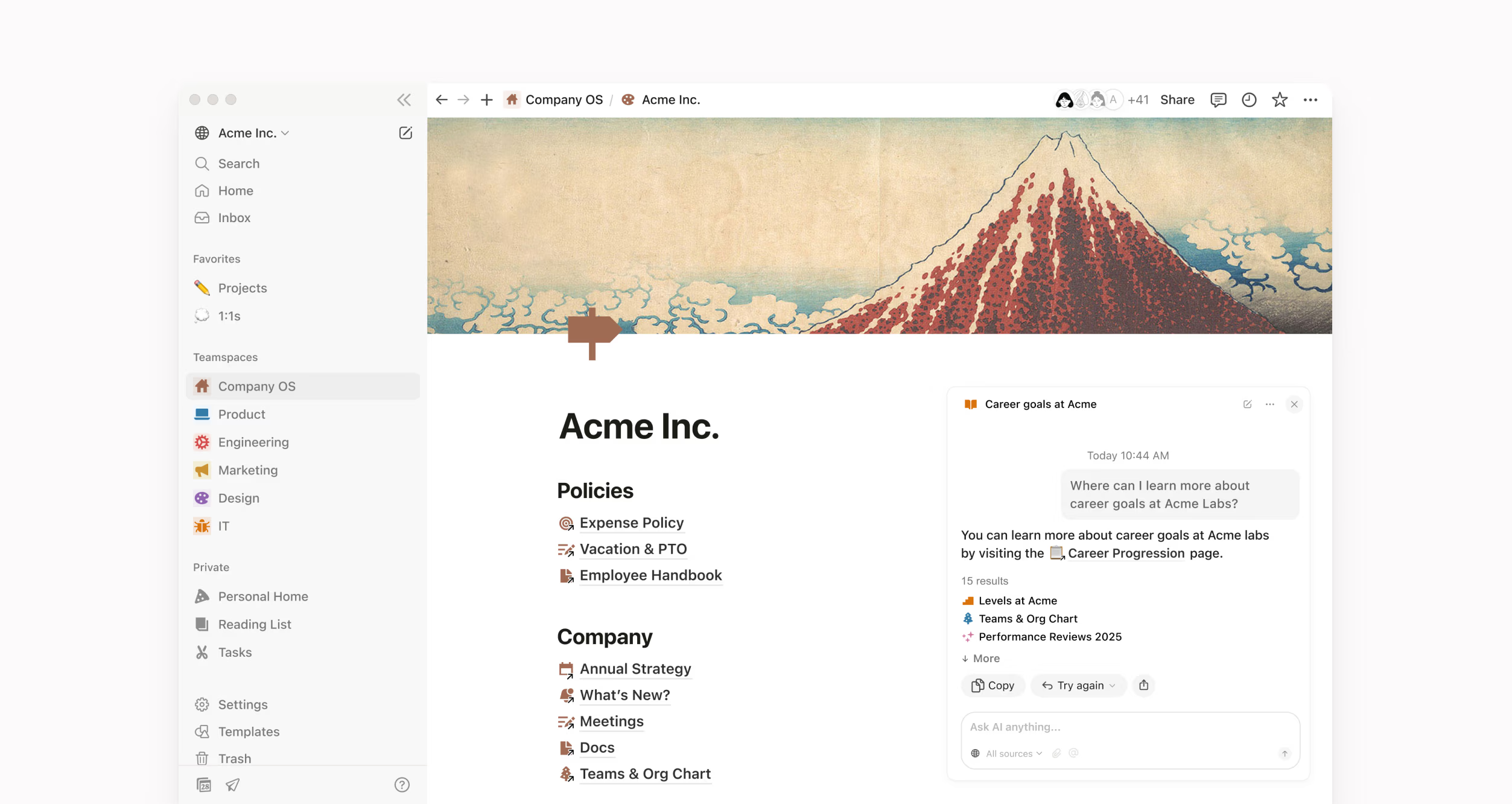
Notion is a document-based collaboration platform (originally, a note-taking app) that helps you collaborate with team members on collaborative docs. The platform is known for advanced document collaboration capabilities and allows you to create advanced documents with more than 50 types of content. In addition to that, the platform helps you manage projects and tasks, set dependencies between tasks to create a project plan, and create reports to manage project planning activities.
Ease of use and learning: Notion has the steepest learning curve of all the platforms listed here because it is not designed as a typical project management software. It is a highly customized platform that can be used as a project management software, note-taking app, or knowledge management system. But once you get over the initial learning curve, you start enjoying the freedom and flexibility of the platform. As far as the interface is concerned, it has a modern and intuitive interface.
Pricing & value for money: Notion is an expensive software. The value of money depends on the use case. If you are not using any knowledge management system and need strong document creation capabilities, Notion can provide you a decent value. Just keep in mind, Notion AI, just like ClickUp AI and Asana AI, charges you extra per user per month.
Key features
- Pages to help you take notes with more than 50 content types, including text, headings, tables, to-do lists, code snippets, videos, and Mathematical formulas
- Templates to help you manage projects and tasks
- ‘Blocked by’ and ‘Is blocking’ dependencies to help you set and manage the dependencies between tasks or projects
- Integrations, automation, & AI to automate work management
Pros
- High degree of customizability and flexibility
- High level of organization to create an internal wiki for knowledge management
Cons
- Not easy to learn, steep learning curve, and requires onboarding training
- Expensive paid plans from small to mid-sized businesses start from $10 per month per user
- Notion has no chat, but page comments
Pricing
Notion offers four plans:
- Free: Free for individual usage
- Plus: $10 per member per month, billed annually
- Business: $20 per member per month, billed annually
- Enterprise: Custom pricing
Ratings
- Capterra: 4.7/5
- G2: 4.7/5
Check out: My in-depth review of Notion for project management
9. Jira: Best for software development projects

Jira is an issue tracking and project management software designed for software development teams. It directly supports the implementation of Agile methodologies with features like Scrum board with Story point calculation, Kanban board with WIP limits, Backlog prioritization, Sprints, Agile task hierarchy (Epic > Story > Sub-task), and burn-down charts. If you are looking for project planning software for software development projects, Jira is the most suitable option for you.
Ease of use and learning: Jira is not at all easy to use. It comes with a steep learning curve. Your team needs dedicated onboarding training and support to learn to use the tool. Considering the technicality of the software development work, the Jira user interface is not bad. However, it is generally complex for non-technical users.
Pricing & value for money: Jira offers high value for money for software development teams with a wide range of features directly supporting agile methodologies. However, small teams may find Jira expensive and explore other options like monday.com and ClickUp.
Key features
- Scrum and Kanban boards to manage the project work of software development teams
- Issue management to create, prioritize, assign, and track issues
- Timeline to visualize the project plan, roadmap, and responsibilities
- Burn-down charts, velocity charts, and cumulative flow diagrams for data-driven insights into project performance
Pros
- Integrates natively with most third-party apps used by software developers, such as GitHub, VSS, and other CI/CD & testing apps.
- Highly customizable dashboard allowing you to display key metrics and monitor project performance effectively.
Cons
- Steep learning curve. My team member took three days to just explore Jira
- Not an ideal work management solution for non-technical teams
Pricing
Jira offers four plans:
- Free: Free for up to 10 users
- Standard: $8.60 per user per month, billed annually
- Premium: $17 per user per month, billed annually
- Enterprise: Custom pricing
Ratings
- G2: 4.3/5
- Capterra: 4.4/5
Read more: Best Jira alternatives & competitors
How to choose the right project planning software?
To choose the right project planning software, here are some of the factors you need to keep in mind:
- Identity features: Identify your needs and translate them into the features required. Project planning involves discussions, file sharing, and project creation. List out all the must-have features. Top features include task hierarchy, task management, custom workflow, Gantt chart, discussion board, calendar, time tracking, multiple project views, custom filters, project reports, custom access, and integrations. Also, take into account the special features such as workload balancing, automation, and advanced reports.
- Research online and shortlist the top software: Start with the software provider’s website. Look for all the features you need. Create a spreadsheet to make comparisons. Contact sales to know more about the tool. Shortlist the software that fulfills your needs.
- Compare pricing: Pricing is often one of the biggest decision-making factors. Compare the pricing. Find out the tools that offer the best value for money. Keep in mind scaling capabilities and pricing in mind while making comparisons.
- Read reviews: Read the real users’ reviews on public software review websites like G2, Capterra, and Gartner. Go through neutral expert in-depth reviews on websites like PCMag and Reddit. It will help you make an informed decision.
- Enroll for a free trial: To get a user experience of the platform, enroll for a free trial. Take feedback from the team on user interface, learning curve, and overall functionality fit. Choose the tool that best serves your organization’s needs.
What are the common challenges teams face without project planning software?
The most common challenges teams often face without dedicated software include a lack of centralized visibility, which leads to miscommunication and duplicated efforts. Deadlines and task dependencies are difficult to track, making it easy for important steps to be missed. Resource management becomes a guessing game, often resulting in overallocation or idle team members. Status updates require constant manual meetings, and decision-makers lack real-time data, slowing down responses to issues. This ad-hoc approach typically creates siloed information, inefficiency, and a higher risk of project overruns and failure.
How is project planning software different from simple task management tools?
Task management tools excel at organizing individual to-do lists and tracking their completion. They focus on the “what” for a person or a small team. Project planning software, however, provides a higher-level strategic view of the entire project. It connects tasks through dependencies, maps them to a master timeline (Gantt charts), and integrates resource allocation, budget tracking, and milestone management. While task tools manage work in the present, project planning software helps managers forecast, schedule, and optimize the entire project lifecycle from start to finish.
What are the benefits of project planning software?
Using project management software leads to centralization of data, which results in enhanced visibility across processes, helps ensure accountability, and improves operational efficiency by bringing people, projects, workflows, and documents to one place. This leads to the following key benefits of using project planning software.
- Create an effective project plan with centralization of data, people, and processes
- Improve efficiency
- Improve accountability
- Ensure participation and transparency with early stakeholder involvement and engagement
- Quick plan to execution with all activities happening in one place
How can project delays be prevented with planning software?
Project planning software helps prevent delays by providing foresight and clarity. It allows managers to map out all tasks and, crucially, their dependencies, so a delay in one area automatically flags an impact on subsequent steps. This enables proactive rescheduling. The software also facilitates realistic timeline setting by visualizing the critical path. Automated reminders for upcoming deadlines and milestones keep the team on track. Furthermore, by providing a single source of truth, it reduces miscommunication and rework, ensuring everyone is aligned and can swiftly address potential bottlenecks before they cause significant setbacks.
How can project planning software reduce resource conflicts?
These tools provide a centralized, visual overview of all team members’ assignments and workloads across every project. Managers can see who is working on what and when, clearly identifying instances where a person is over-allocated or double-booked. This visibility allows for proactive resource leveling – reassigning tasks or adjusting timelines to balance the load before conflicts arise. By matching tasks to available resources based on skills and capacity, the software ensures that work is distributed evenly, preventing burnout and ensuring that no single person becomes a bottleneck for multiple projects.
